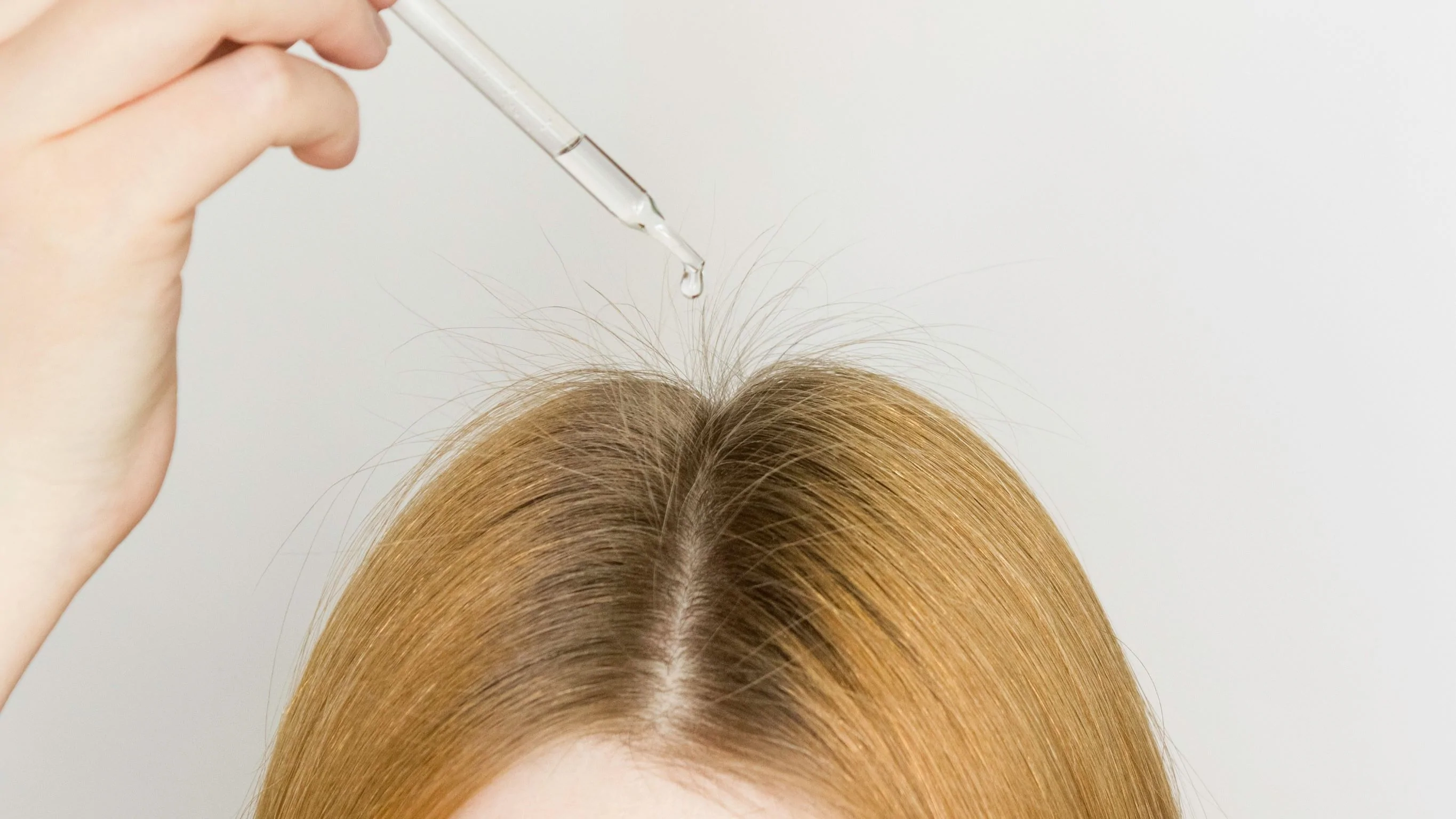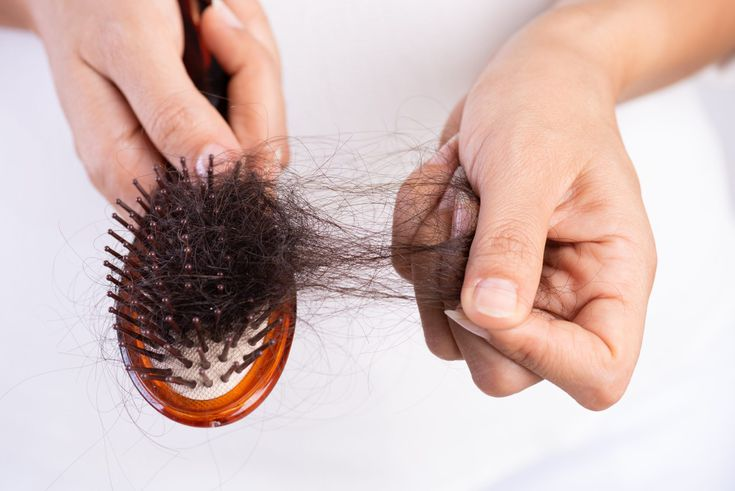Women with female pattern baldness, also called androgenetic alopecia, lose about 150 hairs a day, which is more than the average 50–100 hairs that women without lose every day.
Once they are gone, it takes an awfully long time for hair to grow back, so it's best to treat hair loss as soon as possible with effective solutions.
Minoxidil is hailed as a great way to treat hair loss in men, but can women also use it?
We'll answer every question you might have about minoxidil for women in this article. We'll also tell you ladies about some great alternatives to minoxidil that are effective without the side effects.
Table of content
What causes hair loss in women?

Some hairs fall out while others grow in. This is part of how nature works. When the balance is upset—when more hair falls out than grows back—this is called hair loss.
Here are some of the common causes of hair loss in women:
- Hairstyle: Tight ponytails, braids, or corn rows can pull on your roots and cause hair loss. The name for this kind of hair loss is traction alopecia. Damage to hair follicles can cause permanent hair loss.
- Hereditary hair loss: There is a possibility that your family's genes can cause you to thin out your hair on top.
- Aging: Hair loss can be caused by hormonal changes as you age.
- Menopause: It is common for this type of hair loss to worsen during menopause when estrogen levels fall.
- Stress: Stress on the body and mind can both cause hair loss in women.
- Vitamin deficiency (for example, vitamin B12 hair loss)
- Dieting, fasting (rapid weight loss).
- Over-processed scalp hair (breakage).
- Poor blood circulation.
- Hormone changes during pregnancy.
- Hair gel, birth control, diabetes.
- Medications like amlodipine, steriods, gabapentin, creatine.
As your leading source for hair health information over the past 4 years, we never compromise on accuracy. When it comes to your health, you deserve information you can truly rely on - and earning your trust is our top priority.
Here's how Scandinavian Biolabs ensures every piece of content meets the highest standards of accuracy and integrity:
- Credentialed Experts: Our reviewers are actively practicing doctors and medical researchers
- Stringent Reviews: Content undergoes rigorous editing by subject specialists and review by a practicing doctor.
- Evidence-Based: We rely on well-established research from trusted scientific sources like peer-reviewed journals and health authorities.
- Full Transparency: Our editorial standards, writer credentials, reviewer credentials, correction process, and funding are all publicly documented.
- Independent Voice: While we do promote products, we operate in a vacuum to business operations. Our main goal is just an unwavering commitment to providing medically-sound guidance.
You can count on Scandinavian Biolabs to consistently deliver the trustworthy health information you deserve. Read our Editorial Standards.
What is minoxidil and how does it work?

Minoxidil solution, a clinically proven treatment for hair loss, is applied directly to the scalp to promote hair growth.
It comes as a topical foam, which you put directly on your scalp, and as a medicated topical solution that you put on with a dropper bottle. Minoxidil is clinically teTo regrow hair in both males and females.
The active ingredient in Rogaine, widely known as Regaine for women in some regions, is minoxidil, a substance renowned for its efficacy in hair regrowth.
The FDA has approved it as a treatment for male and female pattern hair loss (FPHL). Minoxidil will need to be used for several months before minoxidil results are visible.
One of the best things about minoxidil is that it can be bought without a prescription. This means that you don't have to make an appointment with your doctor or a dermatologist to use it.
By making the blood vessels in your scalp bigger, minoxidil can help stop hair loss and, in some cases, even make it grow back. This makes the blood flow better to the hair follicles, so they can get more oxygen and nutrients. This allows them to grow healthy hair.
There are 3 stages to the hair growth phase. The growth stage, the change stage, and the resting stage. During the resting phase, hairs get a break from growing while new hairs start to grow. After 3 months of being in the resting phase, the hair falls out and a new one grows in its place.
In MPB, hairs don't spend as much time in the growing stage, so they fall out much faster. Minoxidil foam works by transitioning hair follicles from their resting phase to their growing phase, actively promoting hair growth.
It also works by making the growth phase of the hair last longer. This will make your hair grow faster and better.
Can women use minoxidil for hair loss?

Minoxidil also known as Rogaine or Women's Rogaine, can be used by women.
Minoxidil was first made for men only, but now it is an over-the-counter drug approved by the FDA that can be used to treat hair loss in both men and women.
It can treat a variety of hair problems. You can use minoxidil for receding hairline, minoxidil for traction alopecia, minoxidil for frontal baldness and minoxidil for temples. In special cases, hair clinics might recommend minoxidil after hair transplant to support regrowth.
Studies show that after 24 weeks of use, it significantly increases the total number of hairs, making hair fuller. You can get it in a 2% topical solution or a 5% topical foam. There's also a 5% topical solution, but it's a minoxidil for men.
The reason for this is that a higher concentration of Minoxidil can also cause unwanted hair growth on other areas of the face and body in women (which is usually not a problem for men).
Minoxidil is not recommended for sudden, unexplained, or patchy hair loss. It is also unsuitable for women who lose hair after having a baby.
How does minoxidil for women work?
Minoxidil works the same way on women as it does on men. it widens your blood vessels, which sends more blood and nutrients to your hair follicles. This makes your hair grow fuller. Scientists aren't sure how minoxidil stops hair from falling out, but it seems to keep hair in the active growing phase (anaphase) for longer.
While minoxidil is available without a prescription, it's important to see your doctor before using minoxidil for hair loss.
This is because minoxidil can cause side effects sexually, physically and mentally. Mild symptoms include scalp irritation, unwanted hair growth on other parts of the body, and dizziness. Other users also experienced these minoxidil side effects after stopping.
How should women use minoxidil?
They are available as minoxidil foam and liquid Treatment, which means that you put it on your scalp and not on your hair. Instructions for dosing are usually as follows:
- Minoxidil 5% topical foam: apply ½ a capful of minoxidil once a day
- Minoxidil 2% topical solution: apply 1 ml two times a day
Note: instructions are informative, please use as directed on the label.
To apply minoxidil, you start by massaging it into your scalp with your fingers, and you should wash your hands right away afterward. Apply the treatment at least two hours before bedtime to give it time to dry completely.
This may help keep the minoxidil from spreading to other parts of your body while you sleep. Minoxidil can also leave stains on clothes or sheets if your scalp isn't completely dry after using it.
It's important to remember that it needs to be used every day to keep working. If you stop taking minoxidil, you will start losing hair again in three months.
Minoxidil side effects in women
Even though minoxidil solutions can cause a lot of side effects, some of which can be very bad, these are the ones that women most often experience:
- Minoxidil shedding
- Hair grows on the face or forehead
- Damage to the skin
- Allergy reaction
- Fainting
- Pain in the chest
- Hands or feet that swell up
- Gaining weight for no reason
- Exhaustion
- Difficulty breathing
Talk to your healthcare provider if you experience any of these serious side effects.[[quote]]“The authenticity of libido related side effects of minoxidil are still under review. The major side effect that you should consider is alterations seen in blood pressure.”
— Dr. Ahmad Chaudhry M.B.B.S.[[quote]]
6 best alternatives to minoxidil for women
When minoxidil is not working, our instinct is to turn to a minoxidil alternative That can do the job equally, if not better.
Or, simply put, you're not willing to risk the side effects.
Bio-Pilixin Hair Growth Routine for Women

If you're looking for an alternative to minoxidil, the Bio-Pixilin Hair Growth Routine for women is designed to help support the appearance of thicker, healthier hair.
This three-step routine is designed to nourish your hair and support the appearance of thickness and vitality.
The best part is that it is made with high-performing ingredients that are 100% vegan and naturally derived. You can use our products with confidence
The routine has undergone clinical testing, with some users reporting visible changes in as little as 150 days.
If you're not satisfied, we offer a 150-day money-back guarantee.
So why wait? Give the Bio-Pixilin Hair Growth Routine for Women a try today!
Other drug medications

The most popular drug alternatives to minoxidil are:
- Finasteride (see our finasteride and minoxidil comparison)
- Spironolactone
- Flutamide
- Dutasteride
- Nanoxidil
Several oral prescription medications may be effective for women who have a hormonal component to their hair loss (did you know, you can use oral minoxidil for hair growth, too?)
These medications work by affecting hormone levels and can be prescribed "off-label" for hair loss in women.
These medications may be effective in reducing hair loss and promoting new hair growth, but they can also cause side effects such as fatigue, weight gain, and dizziness. So it's not a really good choice if you're looking to avoid side effects.
Talk to your healthcare provider about whether these medications may be right for you.
Low-level laser therapy (LLLT)
Low-level laser therapy (LLLT) is a treatment for female pattern hair loss that you can do at home, but it’s not shown to be very effective. Lllt may effectively treat hair loss and stimulate hair regrowth, but more research is needed in this area.
The FDA has approved low-level light therapy devices (combs, helmets, and other devices) to treat both male and female hair loss. Talk to your healthcare provider about whether lllt may be right for you.
Microneedling

Microneedling is a minimally invasive procedure that is being looked into as a possible treatment for women who lose their hair in a certain way.
During a microneedling session, a doctor or technician rolls fine needles over the scalp's skin to make tiny holes in the top layers of the scalp.
The tiny holes cause the body to start healing the wound, which releases growth factors that may help hair grow.
Also, the wounds can help medicines like minoxidil get into the scalp better. A few small studies show that micro-needling can help hair grow back, especially when combined with other treatments that help hair grow.
The best part? You can do it at home, with a dermaroller (this is the only thing you don't want to skimp on, it's dangerous to use poorly designed dermarollers)
To find out how effective micro-needling and dermarolling may be, it would be helpful to do more research on minoxidil dermarolling.
Platelet-rich plasma therapy (PRP)
Platelet-rich plasma (PRP) therapy is an alternative treatment for hair loss that involves the collection and separation of blood into different parts. Platelets, which are one of the components of blood, receive treatment during prp therapy.
A healthcare provider then injects the platelet-rich plasma into the scalp. PRP has growth factors that may stimulate hair growth, and some surgeons use this therapy in conjunction with hair transplantation. Early clinical results are promising, but there is a need for more research to determine the effectiveness of this treatment in female pattern hair loss.
Hair transplant
A hair transplant is the most invasive treatment for hair loss. It involves surgery to physically move hair follicles from one part of your scalp to the area of hair thinning.
Healthcare providers usually reserve them for people who have already tried medical treatment without success, and some surgeons combine hair transplants with platelet-rich plasma therapy.
Unfortunately, most medical insurance plans do not cover hair transplant surgery so that cost may be an issue for some people.
If you do decide to go with hair transplantation, also ask about stem cell hair transplant, it's a new treatment that might be exactly what you need.
And if you're still on the fence? Check out our pick for the best hair transplant alternatives that you won't have to spend a fortune on.
Is minoxidil safe for women?
Yes, minoxidil is safe for women when used as directed. Minoxidil is FDA-approved for treating female pattern hair loss at a concentration of 2%.
While men can use 5% minoxidil, the higher concentration is not recommended for women due to an increased risk of side effects, such as skin irritation and unwanted facial hair growth.
Women should consult a healthcare professional before using minoxidil to ensure it's suitable for their specific needs.
Can women use minoxidil 5% foam?
Yes, women can use minoxidil 5% foam as a hair regrowth treatment. Minoxidil is a popular treatment for women with female pattern hair loss to help them regrow new hair. Minoxidil 5% foam is an FDA-approved hair regrowth treatment for women.
Source
- https://www.health.harvard.edu/staying-healthy/treating-female-pattern-hair-loss
- https://pubmed.ncbi.nlm.nih.gov/15034503/
- https://www.sciencedirect.com/science/article/pii/S0365059623000533
- https://www.dermatologytimes.com/view/minoxidil-spironolactone-therapy-effective-in-treating-hair-loss-in-women






